

Growing Fabulous Zone Hardy Fig Trees. Got a fig tree?
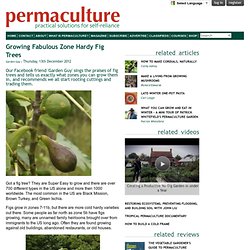
They are Super Easy to grow and there are over 700 different types in the US alone and more then 1000 worldwide. The most common in the US are Black Mission, Brown Turkey, and Green Ischia. Best Ways to Water the Garden. Best Edges for Garden Beds. YOU CAN INSTALL brick, plastic, or metal barriers to block aggressive lawn grasses from spreading into your ornamental beds, but these products are easily damaged by lawn mowers and don't often stay in place.

Instead, here's a simple edging technique that will hold back the grass and help your beds to look sharp. Use it in spring before the perennials fully emerge. 1. USE A SHARP SPADE OR SHOVEL TO CUT STRAIGHT DOWN SEVERAL INCHES INTO THE SOD all along the edge of the bed. (if the bed has been mulched, rake back the mulch before you start cutting.) 2. 3. EDGING TOOLS A spade with a straight cutting blade works well for edging beds, but it should be sharp enough to cut through the sod easily.
No Garden? Here Are 66 Things You Can Can Grow At Home In Containers. By Rachel Cernansky - planetgreen.discovery.com Growing your own food is exciting, not only because you get to see things grow from nothing into ready-to-eat fruits and veggies, but you also don’t have to worry about the pesticides they might contain, and you definitely cut down on the miles they—and you—have to travel.
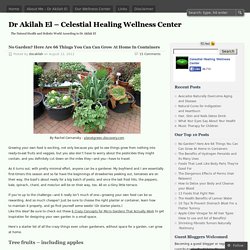
As it turns out, with pretty minimal effort, anyone can be a gardener. My boyfriend and I are essentially first-timers this season and so far have the beginnings of strawberries peeking out, tomatoes are on their way, the basil’s about ready for a big batch of pesto, and once the last frost hits, the peppers, kale, spinach, chard, and mesclun will be on their way, too. All on a tiiiny little terrace. If you’re up to the challenge—and it really isn’t much of one—growing your own food can be so rewarding.
Here’s a starter list of all the crazy things even urban gardeners, without space for a garden, can grow at home. Tree fruits – including apples 1. Citrus fruits 15. 19. 24. Organic Gardening Has Never Been This Easy! Organic gardening is not as easy as some may think!

There is a lot more to it than just watering some seeds or digging around in the dirt. It is truly an art form. It has requires many techniques and products that require a green thumb as well as some hard work to achieve a great organic garden. Dryland Gardening: A Worldwide Report. Friday, June 05, 2009by Barbara Pleasant - Categories: watering, mulch < Back to the GrowBlog Index In an intriguing comment to my blog on the world's best tomatoes, Linda from Northern California asked about “dry farmed” tomatoes, which are grown with little or no supplemental water.

Linda says the dry farmed tomatoes grown by a neighbor have a remarkably intense, delicious flavor, and I’m not surprised. A little drought stress deepens the flavors of ripening tomatoes, melons, and several other garden crops. Enter dryland gardening, in which every drop of water is regarded as precious. Beyond mulches and soaker hoses, gardeners in different parts of the world have discovered more ways to keep plants watered in the dry season: 8 Weeds You Can Eat. If you think everything in your yard that isn't grass must be a nuisance, you're missing out—on a free lunch.
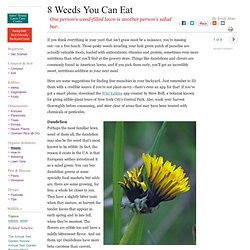
Those pesky weeds invading your lush green patch of paradise are actually valuable foods, loaded with antioxidants, vitamins and protein, sometimes even more nutritious than what you'll find at the grocery store. Things like dandelions and clovers are commonly found in American lawns, and if you pick them early, you'll get an incredibly sweet, nutritious addition to your next meal. Here are some suggestions for finding free munchies in your backyard. Just remember to ID them with a credible source if you’re not plant-savvy—there's even an app for that! If you've got a smart phone, download the Wild Edibles app created by Steve Brill, a botanist known for giving edible-plant tours of New York City's Central Park. How to Design a Garden. Adapted from Ann Lovejoy's Organic Garden Design School, by Ann Lovejoy.

An informal rule of thirds makes for pleasing garden combinations. The thirds refers to plant types. Many gardens can suffer from one of two extremes: they are short on structure and long on seasonal color or they are long on structure and short on seasonal flow. Striking a balance between structure and seasonal interest should be one of the goals of a naturalistic garden. Here is the rule of thirds—and an interesting and insightful new way to look at your garden: One third of the garden's plants are evergreen. Another third of the garden is structural deciduous plants.
Repel Bugs From Your Garden Naturally. Did you know that you can grow plants in your garden which will repel pests and have other beneficial qualities?
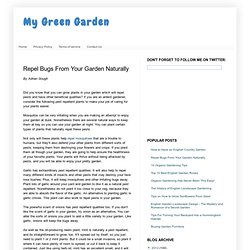
If you are an ardent gardener, consider the following pest repellent plants to make your job of caring for your plants easier. Mosquitos can be very irritating when you are making an attempt to enjoy your garden at dusk. Nonetheless there are several natural ways to keep them at bay so you can use your garden at night. You can plant certain types of plants that naturally repel these pests. 5 Secrets to a ‘No-work' Garden. It took over 20 years of gardening to realize that I didn’t have to work so hard to achieve a fruitful harvest.

As the limitless energy of my youth gradually gave way to the physical realities of mid-life, the slow accretion of experience eventually led to an awareness that less work can result in greater crop yields. Inspired in part by Masanobu Fukuoka’s book, One Straw Revolution, my family experimented with gardening methods which could increase yields with less effort. 20 Ways to control slugs in the permaculture garden or on the allotment. There are many tips about how to fight these invertebrates circulating around allotments and gardens – some are fables, some are more effective than others.
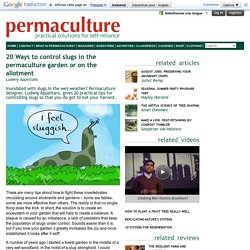
The reality is that no single thing does the trick. In short, the solution is to create an ecosystem in your garden that will help to create a balance. A plague is caused by an imbalance, a lack of predators that keep the population of slugs under control. Sounds easier than it is, but if you love your garden it greatly increases the joy and once established it looks after it self! 10 Organic Gardening Tips. A Quick Guide to Growing Chives. Allium schoenoprasum Chives are bulb plants, although the bulbs are so tiny that you might not realize they're there.
These plants produce beautiful, globelike pink and lavender blossoms. A perennial, chives grow to about 18 inches high and thrive in Zones 3 to 9. Growing Guide Soil preparation: Chives prefers well-drained soil.